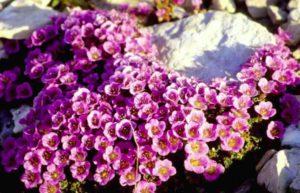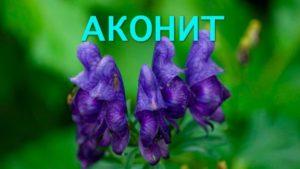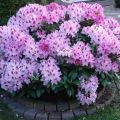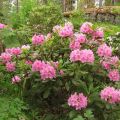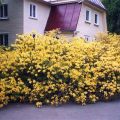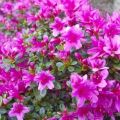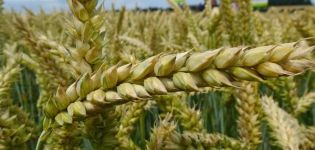Planting and caring for rhododendrons in Siberia, choosing the best varieties
An evergreen perennial shrub - rhododendron (azalea) has won the hearts of gardeners around the world. The plant is considered thermophilic, does not tolerate frosty winters and temperature changes. But thanks to the efforts of breeders, varieties of zoned rhododendrons were obtained, suitable for growing in Siberia, how to properly plant and establish a plant care system in regions with a cold climate, it is worth knowing in advance.
Site requirements
Rhododendrons are thermophilic plants that cannot tolerate direct sunlight. With excessive exposure to the scorching sun, burns form on the leaves, the foliage begins to fall off.
Note: It is recommended to plant rhododendrons on the east or west side of the site.
Wind protection
Azaleas form rather tall bushes from 0.5 meters to 2 meters in height, depending on the variety. The site must be protected from drafts and gusty winds, otherwise the shrub forms an irregular shape, the leaves become noticeably smaller, the flowers fall off at the bud stage.
Illumination
Rhododendrons - plants that prefer partial shade do not tolerate prolonged exposure to direct sunlight. When choosing a place for planting shrubs in Siberia, it is important to observe the "golden mean" rule: the site should be well lit, but the plant should be covered at noon by the shade of other shrubs and trees.
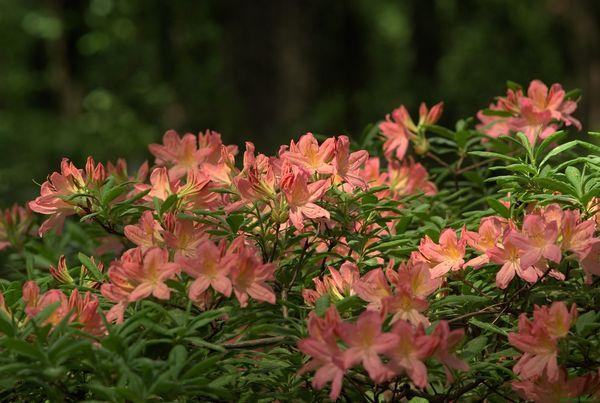
Ground water
Stagnation of moisture at the roots of Japanese shrubs is extremely undesirable, plants cannot grow in wetlands with a high level of groundwater. When planting a rhododendron, expanded clay and sand are poured onto the bottom of the planting pit as drainage.
Neighbors
Single and group plantings of rhododendrons are carried out in various park zones, squares, and personal plots. Shrubs look most impressive in the neighborhood of various types of trees, but they must be planted at a respectful distance from each other so that the plants do not compete with each other for nutrients and sunlight.
Invalid
Unfavorable neighbors for azaleas:
- maple;
- chestnut;
- Linden;
- Birch.
All trees with a highly developed shallow root system and a wide crown are unwanted neighbors of rhododendrons.

Favorable
The perfect neighborhood comes from the combination of azaleas and fruit trees. This is how Japanese gardens are created. Best friends of Japanese bushes:
- cherry;
- Apple tree;
- sweet cherry;
- pear;
- apricot.
These options look good in compositions with roses and various types of deciduous ornamental bushes, as well as in combinations with conifers.
The soil
Under natural conditions, the shrub often grows on rocky soils. Rhododendrons do not need abundant organic fertilizers, they prefer loose soils with high acidity. Alkaline soils are not suitable for this type of plant.
Recommended varieties
Zoned varieties with increased frost resistance are suitable for growing in Siberia. Particular attention should be paid to the representatives of the Finnish selection.
Amursky
A hybrid variety of an evergreen shrub with increased frost resistance. The variety was bred for growing in Siberia and in areas with a cold climate. Forms spherical bushes with large pink flowers, flowering period lasts from May to June.
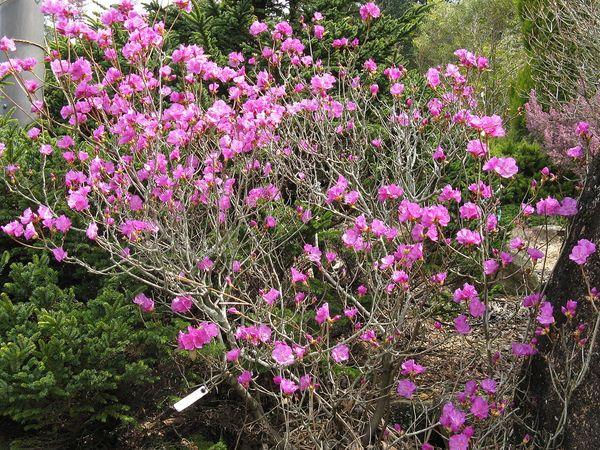
Daursky
Perennial branching shrub with flowers of the original bright lilac color. It can reach a height of 2 meters, is winter-hardy, capable of withstanding temperatures in winter at -29 C. Differs in an early flowering period, picks up buds in April.
Caucasian
An extraordinary undersized shrub with large flowers of a delicate white color. Natural areas of growth - the foothills of the Caucasus, common in Abkhazia. Shrubs of this variety were nicknamed "alpine rose". Can form rhododendron thickets. Possesses medicinal properties. Suitable for growing in southern regions.
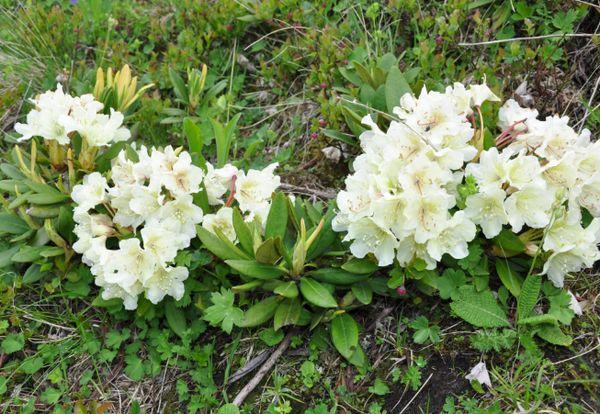
Japanese
Deciduous evergreen shrub up to 2 meters high. Differs in abundant flowering and original color of the leaves - forms yellow-red-orange flowers with a bell shape. Distributed in England and Japan. For the winter period it needs additional shelters.
Northern light
Rhododendron varieties of the Northern Lights series are distinguished by high winter hardiness, are recommended for cultivation in Siberia and the Urals, and include a series of American hybrids. They form powerful sprawling bushes with various color options.
Katevbinsky
A gorgeous spreading bush over two meters high, completely covered with flowers from May to June. Forms a powerful dense crown. Flowers of bright purple color in the form of bells, distinguished by the dark brown color of the trunk. Belongs to the category of centenarians, it can grow in one place for more than a century.

Helliki
Superfrost resistant hybrid of Finnish selection, ideal for growing in Siberian gardens. Forms a chic leafy bush of low height. The flowers are bright, crimson or red. Able to withstand frosts down to -36 C. Growing on acidic soils stimulates the shrub to bloom actively.
Mikkeli
The representative of the Finnish selection. A winter-hardy variety from a series of Katevba rhododendrons. Obtained by crossing the Smirnov rhododendron and the Tigerstedt hybrid. It is a highly branched spreading bush with flowers that resemble lilies of the original pink color. Suitable for growing in Siberia and the Volga region, in the Urals.
Haaga
Rhododendron from the Finnish selection, a descendant of the Katevbinsky shrub. It forms a bush of a beautiful spherical shape with large pink inflorescences, begins to bloom from mid-June. The variety is characterized by increased frost resistance and disease resistance.

Mauritz
Small shrub of Finnish selection with red flowers. An unpretentious variety with high frost resistance.The crown is dense, begins to bloom from the beginning of May. Withstands temperatures down to -30 C. Differs in increased branching, requires pruning to shape.
Peter tigerstedt
Evergreen shrub of Finnish selection with snow-white very large flowers resembling an orchid. Possesses extreme winter hardiness. Taken as a basis for breeding a large number of different hybrids of rhododendrons.
Golden
An evergreen shrub intended for cultivation in Transbaikalia, Siberia, Yakutia. Undemanding to soil, begins to bloom in early May. Inflorescences consist of 5-6 small flowers up to 5 centimeters in diameter, golden yellow in color.
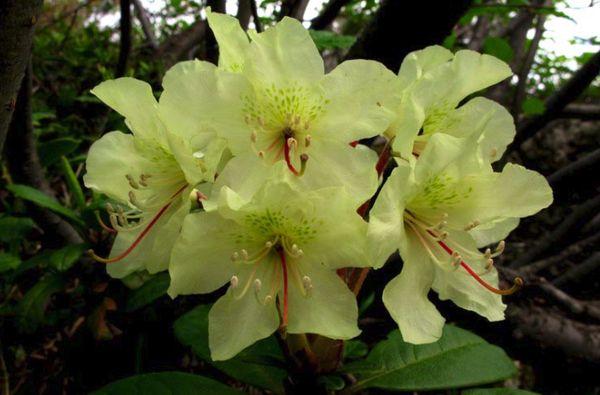
Lebedura
Semi-evergreen shrub up to 1.5 meters high, has a strong branching. Forms flowers in the shape of bells, collected in purple inflorescences. Known for its healing properties. Under natural conditions, it occurs in Western Siberia and the Sayan.
Nova zembla
A perennial evergreen shrub of Dutch selection, loved by gardeners for its high decorative qualities. The height of an adult plant is 2 meters, forming a dome shape. Good winter hardiness is combined with the unpretentiousness of the variety. The flowers are large, up to 10 centimeters in diameter, rich ruby color with original splashes of brown.
Roseum Elegance
Luxurious hybrid variety of English selection. Differs in good frost resistance and the ability to change the color of the leaves. The bushes look gorgeous even without flowers. Inflorescences are large, consisting of pink flowers with fringes along the edges of the petals. Included in the Katevba rhododendron group.
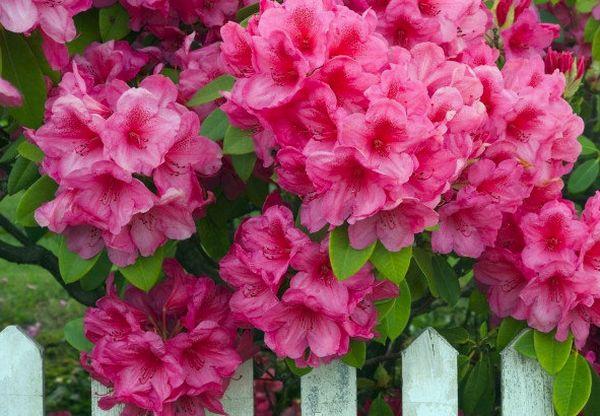
Schlippenbach
Cold-resistant variety adapted for cultivation in Siberia. Forms a spreading bush more than two meters high. Differs in flowers that give off a pleasant strong aroma. Inflorescences are pink. It begins to bloom at the age of 6 years.
Landing dates
The best time for planting young seedlings in the ground is early April. The soil should warm up to +10 C, the threat of frost must be avoided. Sowing seeds for seedlings begins in early February.
In autumn, it is better not to replant young rhododendrons, the plant will not have time to get stronger before the impending winter period.
Open root system
Rhododendron seedlings are often sold with an open root system. On the one hand, the gardener can discern the degree of development of the root system, and on the other hand, unscrupulous sellers often do not create favorable conditions for young bushes. They take root worse and get sick longer.

Closed
Potted seedlings are more viable. Planting is carried out together with an earthen clod, the root system is less injured, the plant takes root faster.
How to choose a seedling
The success of growing rhododendrons largely depends on the choice of a healthy seedling. Before buying planting material, it is necessary to inspect for signs of fungal and bacterial infections, to assess the degree of development of the root system.
Appearance
What should a healthy seedling look like? Main features:
- The age of the bush is 2-4 years, it is during this period that the seedling takes root best.
- The root system is well developed, many branches extend from the base of the root, there are no decaying parts.
- Leaves of uniform saturated color, without spots and scuffs.
- The trunk is strong, without plaque and damage.
Pay attention to the manufacturer of the seed. For cultivation in Siberia, it is recommended to choose varieties of Finnish selection.

Bad signs
If signs of unfavorable conditions of keeping and symptoms of diseases are noticeable on a young seedling, the purchase should be postponed. Unfavorable signs are: the presence of pimples on the leaves, "wet" spots and nodules on the roots.
Landing in a permanent place
It is necessary to choose a site for growing rhododendron right away, the plant does not like frequent transplants.The main parameters to consider when choosing a location:
- The site should be well lit, preference is given to the east or west side.
- The distance between neighbors should be maintained, some varieties of rhododendron form sprawling bushes.
- The area should not be swampy, there are no drafts.
The landing hole is dug deep enough. Drainage from expanded clay and sand is installed at the bottom. After planting, the earth is tamped, the bush is watered abundantly. Rhododendrons prefer acidic soils.
Care
Rhododendrons are unpretentious plants. With a well-chosen place, they can grow independently. The main stage of plant care is autumn preparation for winter.
Watering
Azaleas react extremely negatively to excessive watering. Stagnation of moisture at the roots should not be allowed. Plants are regularly irrigated under the root in the dry summer season in the evening or morning hours.
Spraying
The watering procedure is often combined with spraying the leaves. As a prophylaxis against fungal diseases, brilliant green is added to an aqueous solution: 10 drops per 10 liters of water. Do not spray shrubs at noon in the sun, the leaves will get burned.
Weeding
Shrubs must be hilled and loosened 2 times a month. The procedure is combined with weeding and mulching. Humus mixed with sand or peat is used as mulch.
Top dressing
Azaleas do not need abundant organic fertilizing to achieve abundant flowering, plants are planted in acidic soils. Mineral complexes are applied in two stages: before and after flowering.
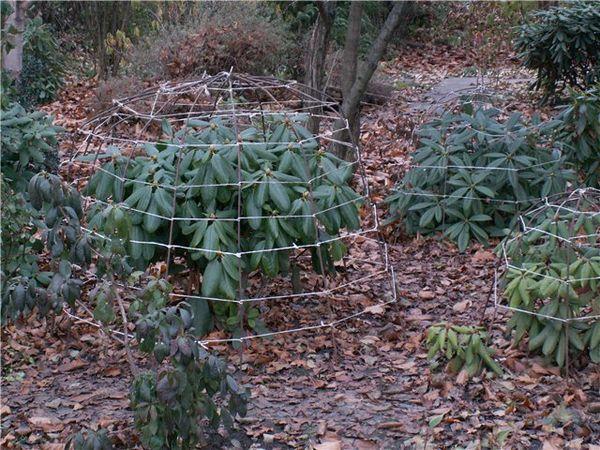
The first
In the spring, at the end of April, the bushes are spud and mulched with a mixture of sand and humus. Immediately before flowering, during the budding period, a complex of liquid mineral fertilizers "for azaleas" is applied.
On a note! One should beware of overfeeding plants with mineral and organic fertilizers, experienced gardeners reduce the recommended dosage by half, diluting the finished complex with water.
During the budding period, shrubs are sprinkled with wood ash as a prophylaxis against pests.
The second
After the azaleas have faded, it is recommended to repeat the application of the liquid mineral complex. To maintain the beautiful and juicy color of the foliage, superphosphate or urea is added in small quantities under the shrubs.
What not to use
When growing rhododendrons, fresh manure must not be used. The plant can get burned, the roots can rot.
Shelter
Despite the fact that many varieties of rhododendrons are declared as super frost-resistant, it is recommended to close the bushes and prepare them for winter. In cold winters with little snow, the bush can freeze out. Spruce branches or special covering material can be used as shelters. Sprinkle the roots with fallen leaves.
Pruning
It is not recommended to prune azaleas for the winter; even foliage is preserved on the bushes, which will additionally protect the plant in winter.
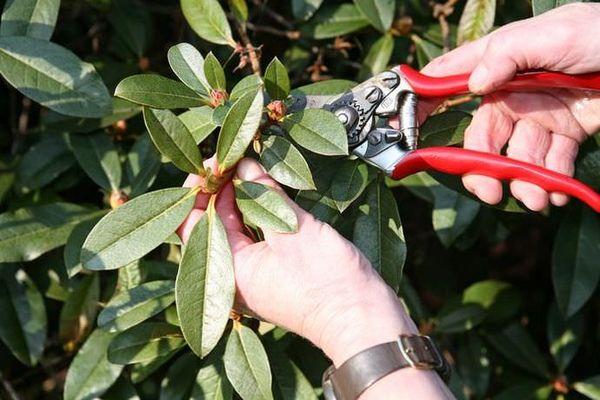
In the spring, they carry out sanitary pruning of the shrub: remove dried leaves and branches, correct the shape of the bush with the help of a pruner.
Mulching
A favorite material for mulching rhododendron bushes is a mixture of sand with humus or peat. Mulching is carried out immediately after weeding and hilling.
Reproduction
It is not difficult to increase the population of beautiful shrubs in your area. Rhododendrons reproduce by dividing the bush, layering, cuttings and seeds.
Seeds
Sowing seeds is carried out in February in seedling boxes. The seeds are staggered at a distance of 3 centimeters from each other, carefully sprinkled with earth and watered with a spray bottle. The box is covered with foil and placed on the windowsill. After 8 days, the first shoots will appear.A month later, the seedlings are dived into individual pots, and at the beginning of May they are planted on the beds "for children" or immediately to a permanent place.

Cuttings
After the flowering of rhododendrons, at the end of June or, conversely, in April, before flowering, the branches are cut from the plants, including 3 internodes. The twigs are dug into pots with earth, watered and placed on the windowsill under glass jars. After 3-4 weeks, buds form on the branch and leaves bloom, and the root system begins to form.
Layers
The lower strong branches of the bush are partially buried in earth. In the internodes of the dug-in branches, future bushes begin to form, they take root and give fresh leaves. After a month, young seedlings are separated from the maternal branch and transplanted to a permanent place.
Dividing the bush
The easiest and most intuitive way. In the spring, strongly overgrown healthy bushes are dug up and divided into 3-4 new bushes. It is recommended to plant young seedlings immediately in a permanent place. Remember to install drainage.
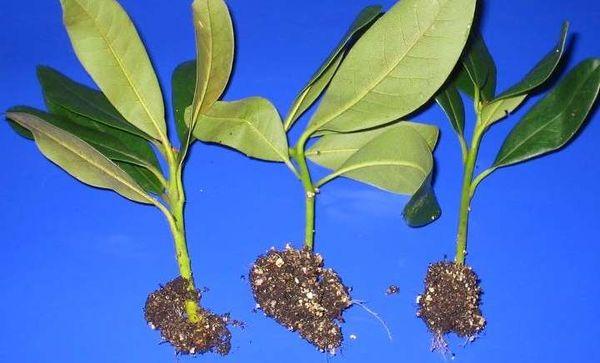
Protection from pests and diseases
In general, rhododendrons rarely get sick with fungal diseases with regular care and the right place of growth.
Fungal diseases
The process of decay and infection with fungal diseases often begins due to excessive watering or the transfer of the disease from neighboring plants. To avoid unpleasant diseases, it is recommended to carry out prophylactic spraying of the plant with Bordeaux liquid, brilliant green or potassium permanganate solution. It is especially important to process shrubs during the budding period.
Rhododendron bug
The main enemy of rhododendron plantations. The bug eats foliage, the shrub loses strength, slows down in growth, looks sloppy. When infected with this insect, various insecticides are used, the drug must be used differently every year, the bug quickly develops immunity to chemicals.
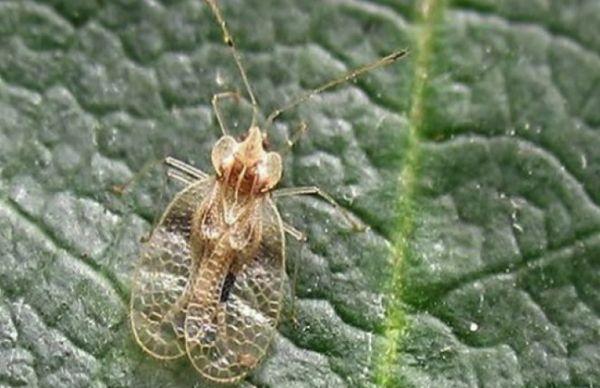
Mealybug
Relatives of the scale insect. Cover the stems of rhododendrons and feed on its juices. You can notice the infection with this parasite right away, the worms are white and well visible on the bush. "Aktara", "Calypso", "Fitoverm" are proven remedies against mealybugs. With a weak infection, you can get by with the treatment of rhododendrons with laundry soap.
Slugs and snails
These parasites are able to destroy all the leaves on the shrub, violate the decorative qualities of the plant, fungi and bacteria are formed on the waste products of slugs and snails that can cause an outbreak of an infectious disease of rhododendron.
As a preventive measure, shrubs are treated with wood ash or mustard powder solution. In case of infection, you can do without the use of pesticides. Slugs and snails can be collected from rhododendrons by hand, it is important to carry out this activity systematically.

Application in landscape
Rhododendrons are an indispensable attribute of Japanese gardens, alpine slides, park areas. Shrubs are planted in groups or create single plantings. Azaleas go well with roses and conifers.
In Japanese gardens, several species and varieties of rhododendrons are planted with different flowering periods. When one bush fades, another blooms. The effect of continuous flowering is created. Rhododendrons, planted next to benches, swings and seating areas, look great.
Group plantings are used to create hedges and curbs. It should be remembered that rhododendron does not lose its decorative properties after flowering.
Through the efforts of breeders, the inhabitants of Siberia can create a Japanese garden in their personal plot. It is important to choose zoned varieties of rhododendrons with good frost resistance. In order to preserve your favorite plants for many years (rhododendrons can live for over 100 years!), It is recommended to close even the most frost-resistant varieties for the winter.
